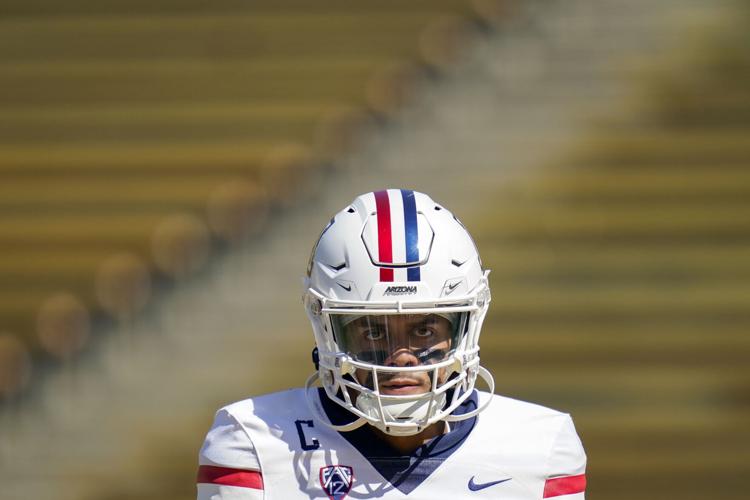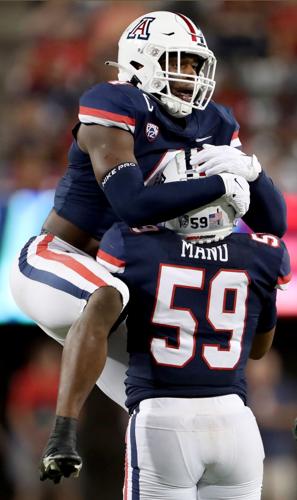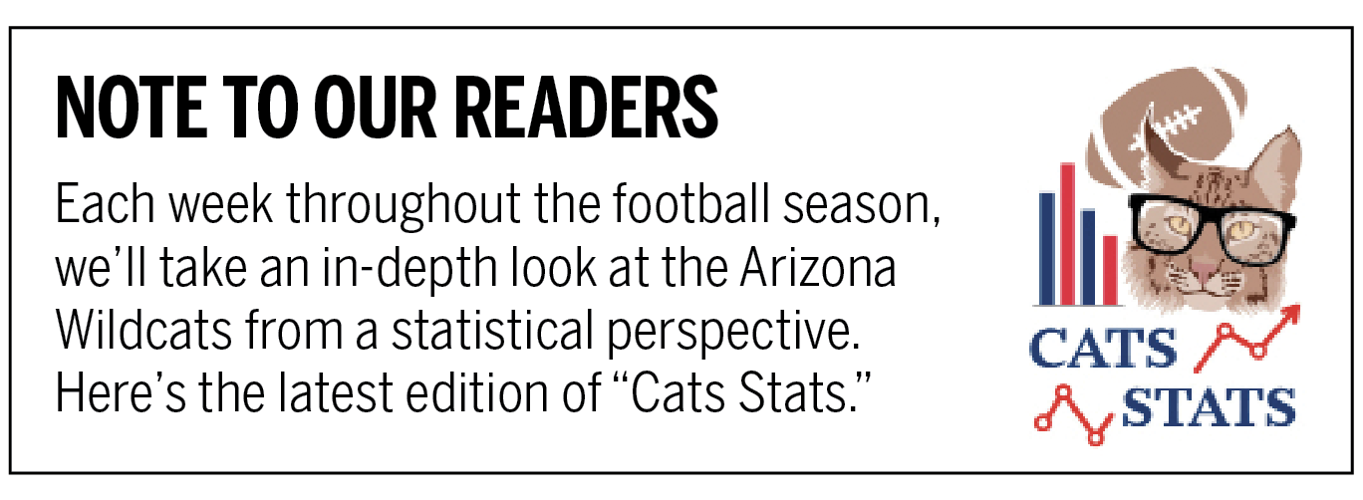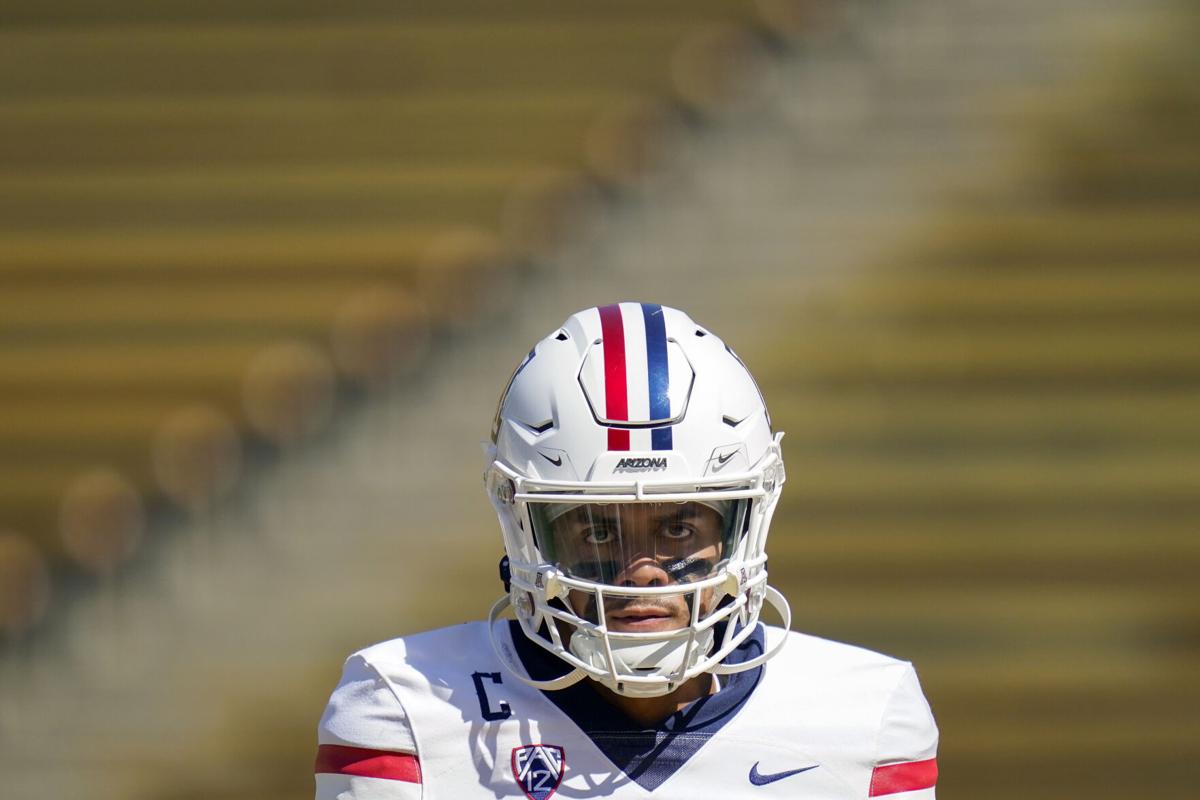Arizona signed nine players from other FBS schools via the NCAA transfer portal, and most of them have roles for the 2022 Wildcats.
Three are main characters on this year’s team: quarterback Jayden de Laura, receiver Jacob Cowing and edge rusher Hunter Echols.
In this week’s pre-Colorado Cats Stats, we’re going to explore how those three have fared so far with their new team. We’ll look at traditional statistics as well as advanced metrics courtesy of Pro Football Focus to examine productivity and usage compared to their previous stops.
QB Jayden de Laura
De Laura has been a slightly less efficient, less effective passer through four games based on his standard numbers. That shouldn’t come as a huge surprise given the transition and learning curve from a run-and-shoot offense to Jedd Fisch’s pro-style scheme.
De Laura’s completion percentage is down about three points, from 63.2 last year to 60.1; his average yards per attempt have gone from 7.8 to 7.5; and his efficiency rating has dropped from 144.8 to 132.6.
Most of those changes are negligible. De Laura’s efficiency rating has fallen the most because his interceptions have risen. De Laura had a 23-9 touchdown-to-interception ratio at Washington State last season. It’s currently 8-6.
In the two games the Wildcats have won, de Laura has a 5-1 TD-INT ratio. In the two games they’ve lost, it’s 3-5.
Now let’s take a look under the hood and see if we can learn more.
De Laura’s adjusted completion rate — which factors in drops on passes thrown on target — of 70.5% is almost identical to last year’s 70.6, according to PFF. What accounts for the difference in standard completion percentage? De Laura has had 13 on-target passes dropped — the same as he had all of last season.
De Laura is ahead of last year’s pace when it comes to “big-time throws,” which PFF defines as passes with “excellent ball location and timing, generally thrown further down the field and/or into a tighter window.” De Laura has 14 big-time throws — the most in the Pac-12 — in 153 attempts; he had 25 in 360 attempts last year. His ADOT (average depth of target) is roughly the same – 10.4 yards in 2022 vs. 10.0 in ‘21.
De Laura hasn’t been as sharp on throws of 20-plus yards. He has completed 10 of 29 attempts for 278 yards with three touchdowns and three interceptions. That’s a completion rate of 34.5% with an average per attempt of 9.6 yards.
At WSU last year, de Laura hit on 26 of 63 passes thrown 20-plus yards — 41.3% — for 890 yards with nine TDs and four picks. His average per attempt was 14.1 yards.
Of course, it’s all relative. Arizona’s top three QBs last year combined to complete only 10 of 45 passes (22.2%) thrown 20-plus yards with one touchdown and six interceptions.
WR Jacob Cowing
Cowing is on pace to easily surpass his reception and touchdown totals from his outstanding 2021 campaign at UTEP.
Cowing had 69 catches for 1,354 yards and seven touchdowns in 13 games for the Miners last season. He’s on pace for 84, 1,158 and 18 in 12 games this season.
Some notes about those projections:
84 catches would exceed Stanley Berryhill III’s team-leading total from last season by one.
1,158 receiving yards would represent Arizona’ first 1,000-yard receiving season since Cayleb Jones had 1,019 yards in 2014.
18 receiving touchdowns would obliterate the school record of 11 (achieved six times by five players).
The one area where Cowing’s standard numbers are down is average per catch. He averaged 19.6 yards last season; he’s currently at 13.8.
That drop-off reflects how Cowing is being utilized. His ADOT is 11.3 yards — almost 4 yards lower than last year’s 15.2. Cowing’s 11.3 ADOT ranks second on the team among regulars — a distant second behind Tetairoa McMillan’s 19.3. (McMillan’s ADOT is the highest of any Pac-12 player who’s been targeted at least 12 times.)
Digging even deeper here, the biggest change in Cowing’s target distribution is that Arizona is throwing him the ball behind the line of scrimmage a lot more. Cowing already has as many targets (12) behind the line of scrimmage as last year. They represent 26.1% of his targets in 2022 vs. 10.8% in ‘21.
Fisch is trying to create ways to get the ball in Cowing’s hands. He remains an effective runner after the catch, averaging 6.2 yards after catch per reception (down slightly from last year’s 7.0). That figure ranks second in the Pac-12 among receives with at least 31 targets. Washington’s Jalen McMillan is first at 6.8. Arizona’s Dorian Singer is third at 5.2.
One other stat worth monitoring: Cowing’s drop rate is sitting at 15.2%, up from 8.0% last year. It was just above 16% in his first two seasons at UTEP.

Arizona defensive lineman Hunter Echols, left, has been a key part of Arizona's defense through the first four games.
DE Hunter Echols
Echols is playing a bigger role for Arizona then he ever did in four seasons at USC. He already has established career highs in tackles (22), sacks (two) and pass breakups (two).
Echols is on pace to play 633 defensive snaps — a figure that would be even higher if he hadn’t missed most of the final two-plus quarters of the opener at San Diego State because of injury. He never played more than 376 snaps in a season with the Trojans.
Echols has eight quarterback pressures, per PFF. If he continues at that rate, he’ll finish with 24. His career high is 15. He had nine last season.
Echols is affecting the quarterback more despite rushing the passer a little less on a percentage basis. Echols has rushed on 35.6% of his defensive snaps, down from 37.7% last year. He has dropped into coverage 13.3% of the time vs. 8.5% a year ago.
Echols has been a more effective pass rusher so far than in any of the past three seasons. He has a pass-rush win rate of 12.7%, per PFF. His best figure from 2019-21 at USC was 10.8%. He was at 7.4% last year.
Echols’ pass-rushing metrics don’t place him among the elite edge defenders in the Pac-12, but he leads UA regulars in pressures and win rate. Echols is tied for the team lead with 13 defensive stops, defined by PFF as tackles that constitute a failure by the offense. His previous career best was seven.
One area where Echols could stand to improve is tackling. (He’s not alone in that regard.) PFF has charged him with six missed tackles for a missed-tackle rate of 22.2%. Echols had only one missed tackle each of the past two seasons and a missed-tackle rate of 5.0%.








